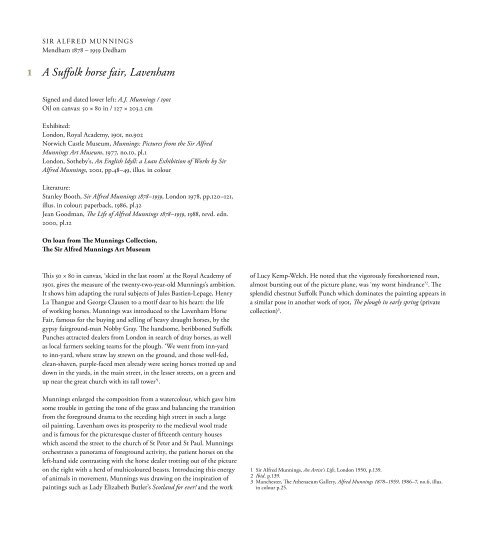An Artist’s Life
Munnings - Richard Green
Munnings - Richard Green
Create successful ePaper yourself
Turn your PDF publications into a flip-book with our unique Google optimized e-Paper software.
1<br />
SIR ALFRED MUNNINGS<br />
Mendham 1878 – 1959 Dedham<br />
A Suffolk horse fair, Lavenham<br />
Signed and dated lower left: A.J. Munnings / 1901<br />
Oil on canvas: 50 × 80 in / 127 × 203.2 cm<br />
Exhibited:<br />
London, Royal Academy, 1901, no.902<br />
Norwich Castle Museum, Munnings: Pictures from the Sir Alfred<br />
Munnings Art Museum, 1977, no.10, pl.1<br />
London, Sotheby’s, <strong>An</strong> English Idyll: a Loan Exhibition of Works by Sir<br />
Alfred Munnings, 2001, pp.48–49, illus. in colour<br />
Literature:<br />
Stanley Booth, Sir Alfred Munnings 1878–1959, London 1978, pp.120–121,<br />
illus. in colour; paperback, 1986, pl.32<br />
Jean Goodman, The <strong>Life</strong> of Alfred Munnings 1878–1959, 1988, revd. edn.<br />
2000, pl.12<br />
On loan from The Munnings Collection,<br />
The Sir Alfred Munnings Art Museum<br />
This 50 × 80 in canvas, ‘skied in the last room’ at the Royal Academy of<br />
1901, gives the measure of the twenty-two-year-old Munnings’s ambition.<br />
It shows him adapting the rural subjects of Jules Bastien-Lepage, Henry<br />
La Thangue and George Clausen to a motif dear to his heart: the life<br />
of working horses. Munnings was introduced to the Lavenham Horse<br />
Fair, famous for the buying and selling of heavy draught horses, by the<br />
gypsy fairground-man Nobby Gray. The handsome, beribboned Suffolk<br />
Punches attracted dealers from London in search of dray horses, as well<br />
as local farmers seeking teams for the plough. ‘We went from inn-yard<br />
to inn-yard, where straw lay strewn on the ground, and those well-fed,<br />
clean-shaven, purple-faced men already were seeing horses trotted up and<br />
down in the yards, in the main street, in the lesser streets, on a green and<br />
up near the great church with its tall tower’ 1 .<br />
Munnings enlarged the composition from a watercolour, which gave him<br />
some trouble in getting the tone of the grass and balancing the transition<br />
from the foreground drama to the receding high street in such a large<br />
oil painting. Lavenham owes its prosperity to the medieval wool trade<br />
and is famous for the picturesque cluster of fifteenth century houses<br />
which ascend the street to the church of St Peter and St Paul. Munnings<br />
orchestrates a panorama of foreground activity, the patient horses on the<br />
left-hand side contrasting with the horse dealer trotting out of the picture<br />
on the right with a herd of multicoloured beasts. Introducing this energy<br />
of animals in movement, Munnings was drawing on the inspiration of<br />
paintings such as Lady Elizabeth Butler’s Scotland for ever! and the work<br />
of Lucy Kemp-Welch. He noted that the vigorously foreshortened roan,<br />
almost bursting out of the picture plane, was ‘my worst hindrance’ 2 . The<br />
splendid chestnut Suffolk Punch which dominates the painting appears in<br />
a similar pose in another work of 1901, The plough in early spring (private<br />
collection) 3 .<br />
1 Sir Alfred Munnings, <strong>An</strong> <strong>Artist’s</strong> <strong>Life</strong>, London 1950, p.139.<br />
2 Ibid. p.139.<br />
3 Manchester, The Athenaeum Gallery, Alfred Munnings 1878–1959, 1986–7, no.6, illus.<br />
in colour p.25.


